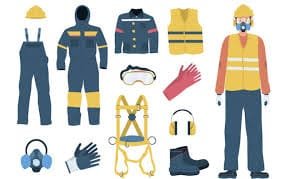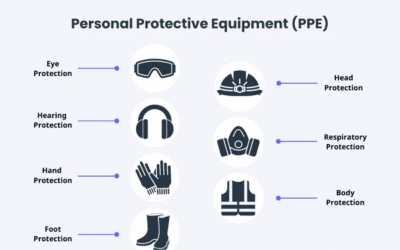PPE List: Introduction and Why It Matters
Imagine walking into a noisy factory without ear protection or stepping into a hospital ward without gloves. Sounds risky, right? That’s the reality many workers would face without personal protective equipment (PPE). PPE is more than just a workplace requirement—it’s literally the armor that keeps millions of workers safe every single day.
From helmets and safety boots to masks and gloves, the right PPE list ensures safety in industries like healthcare, construction, manufacturing, and research. In this detailed guide, we’ll break down everything you need to know about PPE—what it is, why it matters, and a complete list of equipment you should never overlook.
Understanding Personal Protective Equipment (PPE)
What is PPE?
Personal Protective Equipment (PPE) is any gear or clothing designed to protect the wearer from workplace hazards. It acts as a barrier between you and risks such as chemicals, flying debris, falling objects, noise, or infectious diseases.
Importance of PPE in Workplace Safety
While training and hazard control reduce risks, accidents can still happen. PPE is the last line of defense when other safety measures fail. For example, a helmet won’t stop an object from falling, but it will protect your head from serious injury.
PPE and Global Safety Standards
Organizations like OSHA (Occupational Safety and Health Administration), WHO (World Health Organization), and ISO (International Organization for Standardization) outline standards for PPE use. Following these ensures equipment is tested, durable, and effective.
Categories of Personal Protective Equipment
Here’s a detailed PPE list by category:
Head Protection
Head injuries can be life-threatening, making helmets and caps critical in hazardous environments.
Helmets and Hard Hats
Provide impact resistance against falling objects and electrical hazards. Commonly used in construction, mining, and heavy industries.
Bump Caps
Lightweight headgear that protects against minor bumps—perfect for warehouses or low-clearance areas.
Eye and Face Protection
Your eyes are delicate, and one tiny spark or chemical splash can cause irreversible damage.
Safety Glasses
Shields eyes from dust, flying particles, and light impact.
Face Shields
Cover the entire face, offering protection during welding, grinding, or chemical handling.
Goggles
Seal tightly around the eyes, guarding against liquid splashes, fumes, and fine particles.
Hearing Protection
Exposure to loud noise over time can cause permanent hearing loss.
Earplugs
Compact, cost-effective, and suitable for moderate noise levels.
Earmuffs
Offer higher protection, particularly in constant loud environments like factories and airports.
Respiratory Protection
Clean air is a necessity, not a luxury. Respiratory PPE protects workers from inhaling harmful substances.
Disposable Respirators (Masks)
Includes surgical masks and N95 respirators, effective against dust and airborne particles.
Reusable Respirators
Durable masks with replaceable filters, ideal for long-term use in industries with frequent exposure to fumes or dust.
Powered Air-Purifying Respirators (PAPRs)
Battery-powered systems that deliver filtered air, often used in hazardous chemical or biohazard zones.
Hand Protection
Hands are constantly at risk—cuts, burns, chemicals, and infections.
Disposable Gloves
Widely used in healthcare and labs to maintain hygiene and prevent contamination.
Cut-Resistant Gloves
Protect against sharp tools and materials like glass or metal.
Chemical-Resistant Gloves
Made from rubber, nitrile, or neoprene to withstand corrosive substances.
Body Protection
Protective clothing shields workers from physical and chemical hazards.
Coveralls and Aprons
Provide full or partial body coverage against dirt, chemicals, and sparks.
High-Visibility Clothing
Bright reflective vests and jackets ensure workers are easily seen, especially near traffic or in low-light conditions.
Flame-Resistant Clothing
Essential for electricians, welders, and workers exposed to fire hazards.
Foot Protection
Feet are prone to injuries from falling objects, sharp debris, or slippery surfaces.
Safety Shoes
Provide anti-slip soles and protection from minor hazards.
Steel-Toe Boots
Offer reinforced protection against crushing injuries from heavy equipment.
Fall Protection
Working at heights is one of the most dangerous activities in industries like construction.
Safety Harnesses
Distribute the force of a fall across the body, reducing injury.
Lanyards and Lifelines
Connect harnesses to anchor points, ensuring stability.
Industry-Specific PPE Requirements
PPE in Healthcare
Includes gloves, gowns, masks, face shields, and respirators to protect staff from infections and body fluids.
PPE in Construction
Workers typically need helmets, steel-toe boots, harnesses, gloves, and reflective clothing.
PPE in Manufacturing
Cut-resistant gloves, ear protection, and flame-resistant uniforms are standard.
PPE in Laboratories
Lab coats, safety goggles, gloves, and specialized masks ensure protection from chemicals and biological hazards.
Choosing the Right PPE
Risk Assessment
Always start by identifying hazards before selecting PPE.
Comfort and Fit
Ill-fitting PPE can cause discomfort and reduce productivity. The right fit ensures both safety and efficiency.
Durability and Maintenance
Opt for equipment that can withstand frequent use and can be easily cleaned or repaired.
Proper Use and Maintenance of PPE
Donning and Doffing Procedures
Correctly putting on and removing PPE reduces the risk of contamination, especially in healthcare and chemical industries.
Cleaning and Storage
Dirty or poorly stored PPE can lose its effectiveness. Always follow manufacturer guidelines for cleaning.
Training and Awareness
Workers should be trained not just to wear PPE but to understand its importance and limitations.
Common Mistakes with PPE
Using Damaged Equipment
Even small cracks in helmets or tears in gloves make them ineffective.
Neglecting Proper Training
Many injuries occur because workers don’t know how to use PPE properly.
Ignoring Replacement Schedules
All PPE has a lifespan. Overusing old equipment reduces its protective capabilities.
Future of PPE
Smart PPE Technology
The rise of smart PPE includes helmets with sensors, gloves that detect toxins, and safety vests with GPS tracking.
Sustainability in PPE Manufacturing
Eco-friendly PPE made from recyclable or biodegradable materials is gaining traction as industries move toward greener solutions.
Conclusion
The PPE list is more than just a collection of safety gear—it’s a comprehensive shield against workplace hazards. From healthcare to construction, every industry relies on PPE to safeguard its workers. The key is not just owning PPE but knowing when, how, and why to use it.
Always remember: PPE doesn’t eliminate risks, but it significantly reduces their impact. Think of it as your armor in a world of hazards—never step onto the battlefield without it.
FAQs
1. What is the most common type of PPE?
Gloves and masks are the most common, particularly in healthcare and the food industry.
2. How often should PPE be replaced?
Disposable PPE should be discarded after each use, while reusable gear must be inspected regularly and replaced when worn out.
3. Can PPE eliminate workplace hazards?
No, PPE minimizes risks but should be part of a broader safety program, including training and hazard control.
4. Who is responsible for providing PPE?
Employers are usually responsible for supplying workers with the appropriate PPE.
5. What are examples of smart PPE?
Smart helmets with sensors, connected gloves, and high-visibility clothing with tracking technology.


0 Comments